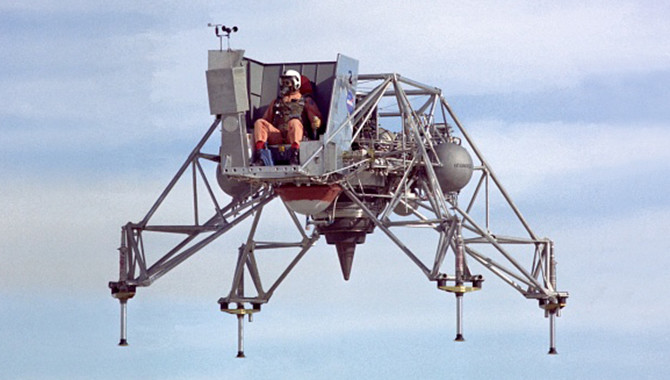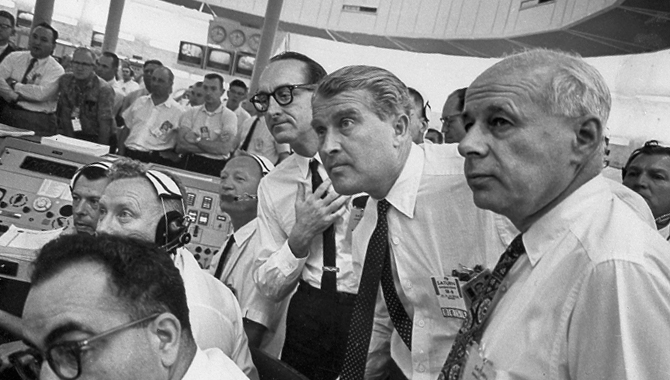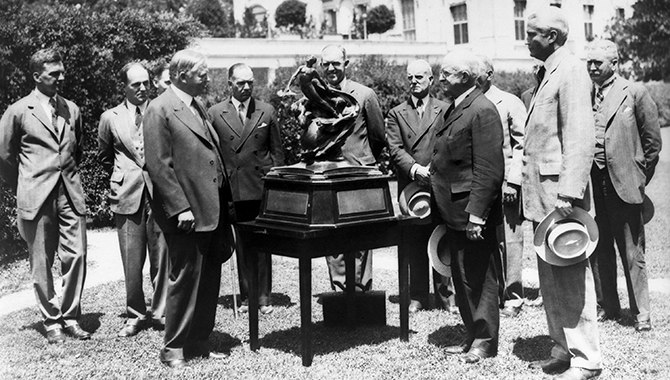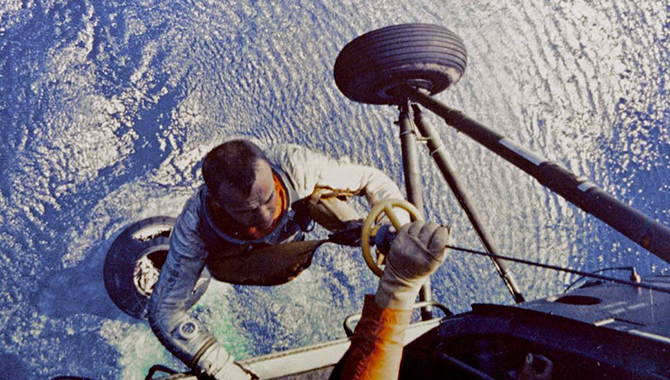
This image of the Lunar Landing Research Vehicle in flight shows the restricted pilot view, which emulated that of the real Lunar Module used by astronauts to land on the moon.
Photo Credit: NASA
The first flight of the Lunar Landing Research Vehicle (LLRV), in October 1964, didn’t go far—but that brief hop supported Apollo 11’s giant leap five years later.
In 1961, President Kennedy set America’s sights on a lunar landing within the decade. NASA was ready to take on the challenge of getting to the moon, but a critical unknown loomed: how to train astronauts to land safely in an environment utterly unlike Earth.
The LLRV, the first free-flight vehicle to simulate moon landings, was developed to address the issue. Conceived initially by Hubert M. Drake and developed in conjunction with Bell Aerosystems, the LLRV was a critical aspect of NASA’s journey toward the moon. In order to descend safely to the lunar surface, engineers needed to assess the issues involved, including the lack of drag and difference in gravity, and astronauts needed to train under those conditions. The LLRV provided their first opportunity.
The vehicle—more a raw frame than a spacecraft—was constructed out of aluminum and mounted on a 4,200-pound-thrust jet engine. The engine raised the LLRV vertically to the desired altitude, where the pilot reduced power so that it only supported 5/6 of the vehicle weight, simulating lunar gravity. He then used a combination of two variable-thrust hydrogen peroxide rockets and another 16 smaller thrusters to control the rate of descent as well as pitch, yaw, and roll. If the main engine failed, the pilot had a series of six backup rockets that would help the LLRV descend safely, plus an ejection seat for emergency use.
In April 1964, two LLRVs were shipped from Bell to NASA’s Flight Research Center (FRC, now Armstrong Flight Research Center). On October 30, 1964, NASA test pilot Joseph A. Walker climbed into LLRV #1 for its maiden voyage. Walker was a veteran of several X-plane programs and had set unofficial speed and altitude records in the X-15. He was the first NASA test pilot to take a rocket plane into space, twice going more than 50 miles above Earth. On August 22, 1963, he soared up over 100 kilometers for which he was posthumously awarded astronaut wings.
But on October 30, 1962, Walker only made it 10 feet off the ground. He took three hops in the LLRV that day for a total of 60 seconds of flight. Over the next year, he and other test pilots flew flight after flight to simulate the handling of a lunar module that astronauts might use to land on the moon, as they examined the issues, challenges, and solutions involved in lunar descent and touchdown.
By the end of 1966, LLRV #1 had completed 198 missions and provided enough information that Bell was ordered to develop three advanced versions of the vehicle, known as Lunar Landing Training Vehicles (LLTVs). These, along with the original LLRVs, were used to train Apollo astronauts at the Manned Space Center (now Johnson Space Center) in Houston, TX.
LLRV #1 flew for the last time on May 6, 1968, with Neil Armstrong at the controls. This was Armstrong’s 21st flight in the LLRV, as he and other astronauts prepared for an imminent mission to the moon. His previous 20 flights had been uneventful and during ascent there was nothing to suggest this trip would be any different. But that changed as he descended. Without warning, the flight controls failed. The vehicle did not respond to any corrective action and Armstrong was forced to eject. He landed safely; the LLRV did not. A propellant leak followed by loss of helium pressure in the attitude rockets was later determined to be the cause of the crash.
After the accident, Armstrong didn’t fly in any of the lunar landing vehicles for more than year. Then, in June 1969, as his Apollo 11 mission approached, he flew several times in an LLTV. He logged 14 total minutes of simulated flight time that month before descending to the surface of the actual moon in the Lunar Module itself. He later stated that the successful Apollo 11 lunar landing would not have been achieved without the simulation training provided by the lunar landing research and training vehicles.
Read an APPEL News article about the Apollo 11 lunar landing.









